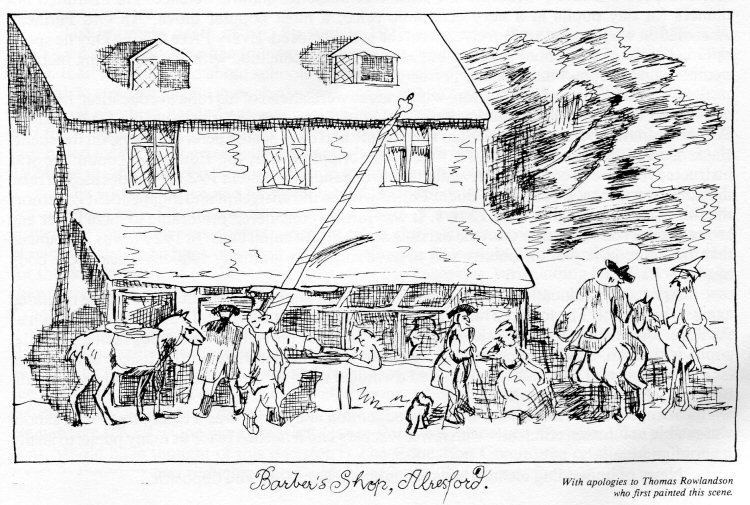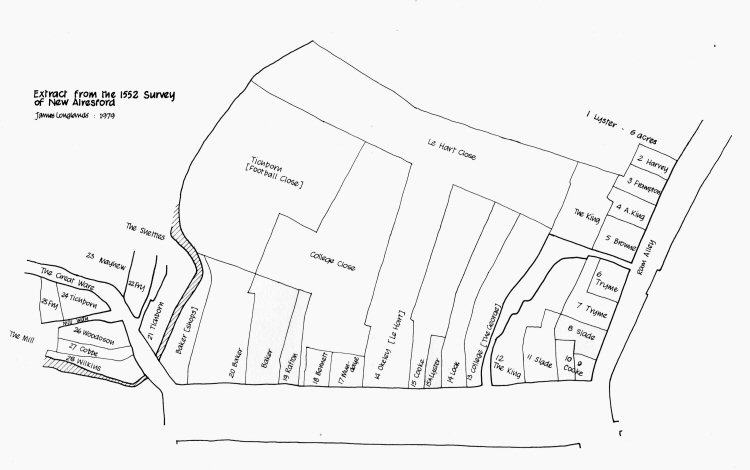AN EXTRACT FROM THE 1552 SURVEY OF NEW ALRESFORD
by THE WORKING PARTY
In 1552 surveys were made of most of the manors held by the Bishopric of Winchester. New Alresford has been fortunate in that its survey — instead of being filed in the archives and forgotten — was copied and translated into modern English in the late XVIIIth century by Robert Boyes, schoolmaster and worthy of the town.
With the kind permission of the Churchwardens, the Working Party has used this copy as a basis on which roughly to reconstruct as a town map a portion of New Alresford as it was in 1552. An overlay shows the same area of the modern town. (These maps were in the centre of Volume 4, and are reproduced below –ed. 2012)
The houses standing in 1552 were all destroyed or badly damaged in the fire of 1689 but in the re-building which followed that disaster it is remarkable how consistent the street lines have remained. Thus, although you may know quite a lot about your neighbours today, the Working party has been able to research something about the people who would have been your near neighbours in 1552. Where the property had subsequent important historical connections for the town, we have added appropriate notes, and if the house is described in detail in Isabel Sanderson's 'Dwellings in Alresford' we have noted the appropriate book and page number (viz: I.S. III page 30).
In the construction of the map we have followed a few basic rules as follows:– A tenement is a house, smaller than a messuage and bigger than a cottage. A tenement with a curtilage is one which stands detached from other houses. A tenement with a court and curtilage is just a trifle more superior. While it is impossible to gauge accurately the extent of a garden, modern maps follow the medieval boundaries and so act as a useful guide.
Our survey starts on the north side of the far end of East Street and in each case the extract from the survey is shown followed by the name of the occupant at that time. By use of the overlay, it is possible for the reader to identify which modern building or buildings are covered.
(Webmaster's note - Click on image below to view larger map and move between modern and old map with overlay.This is best viewed on a PC or Tablet.)
- 'A capital messuage with the buildings thereto belonging and four closes containing about six acres'. Sir Richard Lyster, Chief Justice of the King's Bench, 1546 — 1552. Solicitor General 1522 — 1526. Chief Baron of Exchequer and Knighted 1529. Holbein's portrait of his wife Jane, daughter of Sir Ralph Shirley, is amongst the Queen's pictures at Windsor. Sir Richard was born in Wakefield, Yorks and died in Southampton in 1552, where was his main residence. He owned fifty-seven houses scattered about Alresford.
- 'A tenement with a curtilage'. Richard Harvey. Held in tenure from Lyster. Although destroyed by fire, it is possible that the present building (23 East Street) contains some of the original timbers. I.S. V. p.33.
- 'A tenement with a barn, court and curtilage' Thomas Frampton. The will of his father, in the Hampshire Record Office, shows that the family were weavers and of some substance in the town.
- 'A tenement with a curtilage and a porch' (for which she paid an extra 2d in the rates) Agnes King. Her house passed on marriage to her husband, John Mayhew, who lived on the south side of West Street and is shown to be a considerable property owner.
- 'A tenement with a curtilage' Nicholas Brown.
- 'A tenement with a curtilage'. William Tryme. Leased from Lyster.
- 'A tenement with a curtilage'. William Tryme's own house which stretched back as far as the gardens of houses in Broad Street.
- 'A tenement with a curtilage' Thomas Slade. Rented from Lyster. The Slades were a family of tailors. The father's will of 1547 is in the Hampshire Record Office and shows that he was determined that his family should continue living in the house and lays down the sequence of his children who shall inherit it as Thomas, John, Alice and Christian. The survey shows that there were two houses on this site, both owned by Lyster. See II below.
- 'The Corner tenement of East Street and High Street (that is Broad Street)' rented from Lyster by Lancelot Cooke, who owned the next Tenement.
- 'A tenement in the High Street with a garden' which is now the Horse and Groom. He owned pasture land around which subsequently became the property of the Parish Officers to help provide for the poor of Alresford. I.S. I p.53.
- 'A tenement with a curtilage'. Thomas Slade. See 8 above.
- 'A tenement, with garden adjoining, formerly belonging to the Fraternity of Jesus which by the late Act of Parliament, is granted to our Sovereign the King'. Held in tenancy by William Allen a clothier. This dispossession was a direct result of the Reformation. There were stables and a woodhouse adjoining which were leased to Cooke. In 1588, the property belonged to Arthur Swain of London who may have been connected with Thomas Swain who owned the Alresford Bell Foundry, where in 1760 he cast the bells of Upham. The house was rebuilt after the fire and was used to house the French prisoners of war 1812/13. Currently The Hobby Horse.
- 'A tenement called The George with a garden adjoining which also has a Barn, Malthouse and ground on the east of the way leading to Ram Alley'. The Warden and Fellows of Winchester College. The records of this building are the oldest available in Alresford. In 1410, William and Christina Totterne paid 46/8 for a tenement called Broadeyate, leased for life from the Bishop with two acres of arable land. Their intention was to establish an inn to be called The Angel (College Muniment Room — Alresford No. 51). By 1424, the inn had been built but named The George in recognition of the support of St. George to the English at Agincourt. It was burnt to the ground in 1439 but rebuilt by 1460. There is a list of the medieval landlords. It was destroyed by fire again in 1689 and rebuilt with the rest of Alresford during the XVIIIth century. It remained an inn until 1927.
- 'A tenement with a garden'. Roger Lock. He also possessed a dye house 'upon the marsh of Broad Mead and a shop in the market place'.
- 'A tenement with two gardens'. Lancelot Cooke. A small building (15 a) belonging to Lyster was also here and may account for the two gardens.
- 'A tenement called 'le Hart' with a garden and an acre close at the east end of the garden'. John Okeley. There is an additional note that 'the close of this property abutts on the Lord's Vineyard'. The house was burnt down in the fire of 1689 but immediately rebuilt by Edward Tickeridge. Okeley rented the inn from Lyster and an inventory taken in 1570 after the death of his wife Joan gives a vivid picture of inn life at that period. There was a `laver' with two ewers at the entrance, a long trestle eating table and two round ones for the more important clients. Painted cloths covered the walls and 'playing tabuls and setts of men' were available for entertainment. Upstairs were three lofts furnished as bedchambers for guests, one of which was known as Walop' s chamber' — probably William Walop of Weild.
- 'A tenement'. Thomas Mundaye, who also owned pasture land in the Marsh. Full details of the subsequent history of this property are in I.S. II p.52.
- 'A tenement in possession of William Bennett' and
- 'Two tenements with a court and garden in possession of Richard Rafton in right of his wife, Catherine'. This is the only time we have found the 'Boyes summary' to be in contradiction to the Survey in placing the 'houses as they lie' but there is no doubt that the error was made and that either Bennett's or Rafton's property was set back from the line of houses in a cul-de-sac.
- 'Three tenements with two gardens between the Brook and the land of William Bennett'. William Baker, clerk. This property also included shops on the east of the High Street near the bridge (see illustration A below) and a 'certain dyehouse and close near the Shuttles'. This considerable property was sold to William Oglander who, in 1588, sold it to Sir Richard Norton. It subsequently passed into the hands of the Earl of Hertford, so that it had connections with both sides in the Civil War. See I.S. II p.44 & I.S. III p.30. for the later history of these buildings.
- 'A parcel of land to the north of the Bridge extending between the way leading to the Shuttles and the Brook'. Nicholas Tichborn. This is the site of the present Soke Cottages.
- 'One cottage upon the Great Ware beside the lane leading to the Shuttles'. Isabel Fry. Elsewhere in the Survey it is referred to as two cottages and is the site on which the Globe Inn and Pond Cottages now stand.
- 'One cottage and a garden lying on the Great Ware beside the road'. John Mayhew. In 1585 it belonged to William Burwell, a tanner.
- 'One waste piece called the Crespits'. Nicholas Tichborn.
- 'One cottage and a garden lying at the east end of Mill Lane'. This became the property of the Countess of Banbury and was occupied by John Bower who had a house and tanyard there.
- 'A tenement with a toft or void space of land by the lane called Millway'. Alice Woodoson.
- 'A tenement with a garden'. Roger Cobbe.
- 'A tenement with a garden at the north end of the bridge. Richard Wilkins. The later history of 26, 27 & 28 are described in I. S. I. p.41.
Present resident of houses covered by this research may comment that the house sites of 1552 do not conform to the present sites. It is unlikely that they would for, after two disastrous fires, rebuilding would depend on the whim of new owners or the experience of old owners in siting the new properties amongst the rubble of the old.
Copyright- Alresford Displayed 1979.

